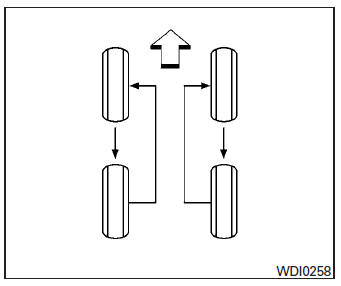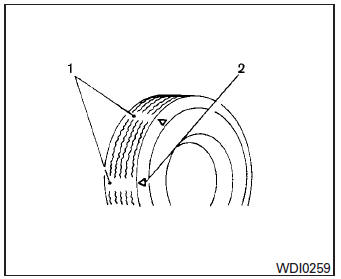Nissan Sentra Owners Manual: Changing wheels and tires

Tire rotation
NISSAN recommends rotating the tires
every 7,500 miles (12,000 km).
See ÔÇťFlat tireÔÇŁ in the ÔÇťIn case of emergencyÔÇŁ
section of this manual for tire replacing
procedures.
As soon as possible, tighten the
wheel nuts to the specified torque
with a torque wrench.
Wheel nut tightening torque:
83 ft-lb (113 N┬Ěm)
The wheel nuts must be kept tightened
to specifications at all times. It
is recommended that wheel nuts be
tightened to specification at each
tire rotation interval.
WARNING
- After rotating the tires, check and
adjust the tire pressure.
- Retighten the wheel nuts when
the vehicle has been driven for
600 miles (1,000 km) (also in
cases of a flat tire, etc.).
- Do not include the spare tire in
the tire rotation.
- For additional information regarding
tires, refer to ÔÇťImportant
Tire Safety InformationÔÇŁ (US) or
ÔÇťTire Safety InformationÔÇŁ
(Canada) in the Warranty Information
Booklet.
|

- Wear indicator
- Location mark
Tire wear and damage
WARNING
- Tires should be periodically inspected
for wear, cracking, bulging
or objects caught in the tread.
If excessive wear, cracks, bulging
or deep cuts are found, the tire(s)
should be replaced.
- The original tires have built-in
tread wear indicators. When the
wear indicators are visible, the
tire(s) should be replaced.
- Tires degrade with age and use.
Have tires, including the spare,
over 6 years old checked by a
qualified technician because
some tire damage may not be obvious.
Replace the tires as necessary
to prevent tire failure and
possible personal injury.
- Improper service of the spare tire
may result in serious personal injury.
If it is necessary to repair the
spare tire, contact a NISSAN
dealer.
- For additional information regarding
tires, refer to ÔÇťImportant
Tire Safety InformationÔÇŁ (US) or
ÔÇťTire Safety InformationÔÇŁ
(Canada) in the Warranty Information
Booklet.
|
Replacing wheels and tires
When replacing a tire, use the same size, tread
design, speed rating and load carrying capacity
as originally equipped. Recommended types and
sizes are shown in ÔÇťWheels and tiresÔÇŁ in the
ÔÇťTechnical and consumer informationÔÇŁ section of
this manual.
WARNING
- The use of tires other than those recommended
or the mixed use of tires of
different brands, construction (bias,
bias-belted or radial), or tread patterns
can adversely affect the ride, braking,
handling, VDC system, ground clearance,
body-to-tire clearance, tire chain
clearance, speedometer calibration,
headlight aim and bumper height.
Some of these effects may lead to accidents
and could result in serious personal
injury.
- If your vehicle was originally equipped
with 4 tires that were the same size and
you are only replacing 2 of the 4 tires,
install the new tires on the rear axle.
Placing new tires on the front axle may
cause loss of vehicle control in some
driving conditions and cause an accident
and personal injury.
- If the wheels are changed for any reason,
always replace with wheels which
have the same off-set dimension.
Wheels of a different off-set could
cause premature tire wear, degrade vehicle
handling characteristics, affect the
VDC system and/or interference with
the brake discs/drums. Such interference
can lead to decreased braking efficiency
and/or early brake pad/shoe
wear. Refer to ÔÇťWheels and tiresÔÇŁ in the
ÔÇťTechnical and consumer informationÔÇŁ
section of this manual for wheel off-set
dimensions.
- Replacing tires with those not originally
specified by NISSAN could affect the
proper operation of the TPMS.
- Do not install a damaged or deformed
wheel or tire even if it has been repaired.
Such wheels or tires could have
structural damage and could fail without
warning.
- The use of retread tires is not
recommended.
- For additional information regarding
tires, refer to ÔÇťImportant Tire Safety InformationÔÇŁ
(US) or ÔÇťTire Safety InformationÔÇŁ
(Canada) in the Warranty Information
Booklet.
|
Wheel balance
Unbalanced wheels may affect vehicle handling
and tire life. Even with regular use, wheels can get
out of balance. Therefore, they should be balanced
as required.
Wheel balance service should be performed
with the wheels off the vehicle.
Spin balancing the wheels on the vehicle
could lead to mechanical damage.
- For additional information regarding
tires, refer to ÔÇťImportant Tire Safety
InformationÔÇŁ (US) or ÔÇťTire Safety InformationÔÇŁ
(Canada) in the Warranty Information
Booklet.
Care of wheels
- Wash the wheels when washing the vehicle
to maintain their appearance.
- Clean the inner side of the wheels when the
wheel is changed or the underside of the
vehicle is washed.
- Do not use abrasive cleaners when washing
the wheels.
- Inspect wheel rims regularly for dents or
corrosion. Such damage may cause loss of
pressure or poor seal at the tire bead.
- NISSAN recommends waxing the road
wheels to protect against road salt in areas
where it is used during winter.
Spare tire (TEMPORARY USE ONLY
spare tire)
Observe the following precautions if the TEMPORARY
USE ONLY spare tire must be used.
Otherwise, your vehicle could be damaged or
involved in an accident:
WARNING
- The spare tire should be used for emergency
use only. It should be replaced
with the standard tire at the first opportunity
to avoid possible tire or differential
damage.
- Drive carefully while the TEMPORARY
USE ONLY spare tire is installed. Avoid
sharp turns and abrupt braking while
driving.
- Periodically check spare tire inflation
pressure. Always keep the pressure of
the TEMPORARY USE ONLY spare tire
at 60 psi (420 kPa, 4.2 bar).
- With the TEMPORARY USE ONLY spare
tire installed do not drive the vehicle at
speeds faster than 50 MPH (80 km/h).
- When driving on roads covered with
snow or ice, the TEMPORARY USE
ONLY spare tire should be used on the
rear wheels and the original tire used
on the front wheels (drive wheels). Use
tire chains only on the front (original)
tires.
- Tire tread of the TEMPORARY USE
ONLY spare tire will wear at a faster rate
than the standard tire. Replace the
spare tire as soon as the tread wear
indicators appear.
- Do not use the spare tire on other
vehicles.
- Do not use more than one spare tire at
the same time.
- Do not tow a trailer when the TEMPORARY
USE ONLY spare tire is installed.
|
CAUTION
- Do not use tire chains on a TEMPORARY
USE ONLY spare tire. Tire chains
will not fit properly and may cause damage
to the vehicle.
- Because the TEMPORARY USE ONLY
spare tire is smaller than the original
tire, ground clearance is reduced. To
avoid damage to the vehicle, do not
drive over obstacles. Also, do not drive
the vehicle through an automatic car
wash since it may get caught.
CAUTION
Tire chains/cables should not be installed
on P205/50R17 size tires. Installation of
the tire chains/cables on P205/50R17 size
tires will cause damage to the vehicle. If
you plan to use t ...
Other materials:
Diagnosis system (BCM)
Common item
Common item : consult function (bcm - common item)
APPLICATION ITEM
CONSULT performs the following functions via CAN communication with BCM.
SYSTEM APPLICATION
BCM can perform the following functions.
Intelligent key
Intelligent key : consult function (bcm - intelligent ke ...
Structure and operation
TRANSAXLE
TRANSAXLE : Cross-Sectional View
Converter housing
Oil pump
Counter drive gear
Control valve
Oil pan
Primary pulley
Steel belt
Secondary pulley
Planetary gear (auxiliary gearbox)
Side cover
Transaxle case
Differential case
Final gear
Reduction gear
Cou ...
C1609 Vehicle speed signal
DTC Logic
Dtc detection logic
DTC
Display item
Malfunction detected condition
Possible cause
C1609
CAN VHCL SPEED
Malfunction is detected in vehicle speed signal that
is output from abs actuator and electric unit (control
unit) via can communication. ...
┬ę 2014-2025 Copyright www.nisentra.com


 Tire chains
Tire chains
